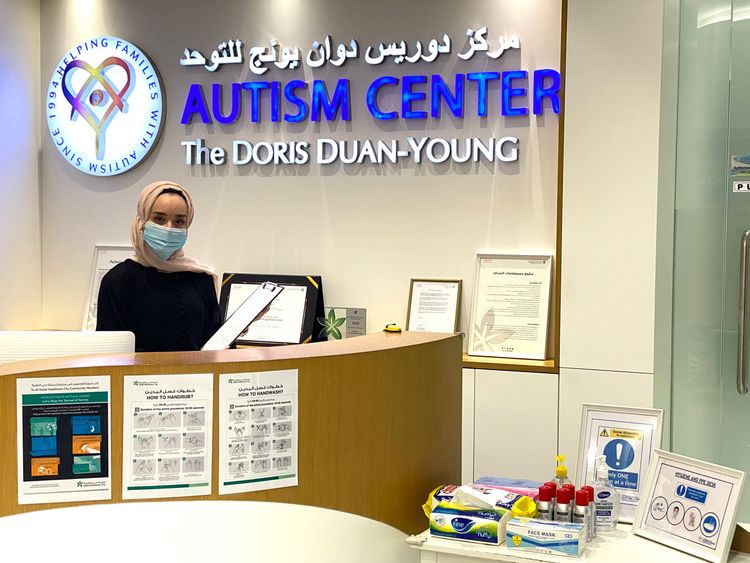التقييم
التقييم
التدريب المجتمعي
AAC: Assistive Augmentative Communications – A speech-Language therapists’ term for communication using a picture board or recorded messages activated by buttons, etc.
ABA: Applied Behavior Analysis – A method of teaching designed to analyze and change behavior in a precisely measurable and accountable manner. Also called behavior modification. Skills are broken down into their simplest components and then taught to the child through a system of reinforcement.
ABC: Autism Behavior Checklist – A diagnostic device for autism. A checklist containing a list of behaviors and weighted scores which appear to be capable of measuring the level of autistic behaviors in individuals. Abstract Thinking – Deductive thinking, not concrete and singles out the rational, logical qualities.
ACCESS – Identification card issued to Medial Assistance recipients; used by Medical Assistance providers to verify client eligibility.
ADA: Americans with Disabilities Act – A civil rights law passed in 1990 that does not allow discrimination against people with disabilities in employment, public service, and public accommodations. Adaptive Skills – (Functional Skills) – those used in daily living such as eating, dressing and toileting. Self-Help Skills.
ADD: Attention Deficit Disorder – Is a syndrome exhibited usually by children aged seven years and below. The disorder is characterized by the child’s persistent impulsiveness, hyperactivity and very short attention span.
Advocate/Advocacy – Someone who takes action to help someone else (as in “educational advocate”); also, to take action on someone’s behalf assuring services, appropriate for you and your child, are received.
AIT: Auditory Integration Training – Developed by Dr. Guy Bernard, an Ear, Nose and Throat physician, to rehabilitate disorders of the auditory system, such as hearing loss.
ALD: Assistive Listing Device – Is any type of device that can help you function better in your day-to-day communication situations.
Aphasia – Loss of ability to use or understand words.
Apraxia – A disorder of voluntary movement, consisting of partial or total incapacity to execute purposeful movements, without impairment of muscular power, sensibility and coordination. The person has difficulty sequencing movements in the service of a goal. May be specific to speech.
AS: Asperger’s Syndrome – A developmental disorder on the autism spectrum defined by impairments in communications and social development and by repetitive interests and behaviors. Unlike typical autism, individuals with Asperser’s Syndrome have no significant delay in language and cognitive development.
ASA: Autism Society of America – Is a voice and resource of the entire autism community in education, advocacy, services, research and support. The ASA is committed to meaningful participation and self-determination in all aspects of life for individuals on the autism spectrum and their families. ASA accomplishes its ongoing mission through close collaboration with a successful network of chapters, members and supporters.
ASD: Autism Spectrum Disorder – Term that encompasses autism and similar disorders. More specifically, the following five disorders listed in DSM-IV: Autistic Disorder, Asperger’s Disorder, PDD-NOS, Childhood Disintegrative Disorder, and Rett’s Disorder.
Assessment – A collecting and bringing together of information about a child’s needs, which may include social, psychological, and educational evaluations used to determine services.
AT: Assistive Technology – Is a generic term that includes assistive, adaptive, and rehabilitative devices and the process used in selecting, locating, and using them. AT promotes greater independence for people with disabilities by enabling them to perform tasks that they were formerly unable to accomplish, or had great difficulty accomplishing, by providing enhancements to or changed methods of interacting with the technology needed to accomplish such tasks.
Auditory Processing – The ability to understand and use information that is heard, both words as well as other nonverbal sounds.
Augmentative Communication – Special devise that provides an alternative for spoken language. For example, photographs and picture exchange communication.
Autism – A disability; characterized by severe language and communication deficits, lack of normal relatedness, bizarre movement and self-stimulatory patterns, lack of normal handling of toys and other objects, and lack of most normal functional skills. Life Long developmental disability, neurological disorder affecting brain function.
Baseline – The current level the child is functioning at before instruction.
Baylet Scales – A developmental assessment used for children age one month to 3 1/2 years old. It is comprised of a mental, motor and behavior scale. This scale has a mean of 100 and a standard deviation of 15.
BHRS: Behavioral Health Rehabilitation Services – Community-based mental health treatment available to children with mental health needs in Pennsylvania.
BSC: Behavior Specialist Consultant – Assists design, goals, techniques & implantation of behavior management plan through a wraparound provider.
BSE: Bureau of Special Education – Part of the Pennsylvania Department of Education that oversees all matters concerning special education.
BSP: Behavior Support Plan/(BIP) Behavior Intervention Plan – Multi-component behavior intervention plans, with multiple layers of support, are in fact the best way to establish effective and comprehensive strategies for addressing challenging behavior. All interventions should be selected based on the results of the Functional Behavioral Assessment and intervention, designed to promote the acquisition of new skills and to decrease problem behaviors. Specific strategies include changing elements of students’ environment to promote positive behavior, teaching new skills to replace problem behavior, and to increase social and academic competencies. The training also focuses on
several methods for using positive consequences to strengthen desirable behavior.
BSU: Base Service Unit – A component of the counties Mental Health/Mental Retardation system that provides services to eligible county residents.
CADDRE: Center for Autism & Developmental Disabilities Research & Epidemiology. The Children’s Health Act of 2000 directed the Center for Disease Control and Prevention (CDC) to establish regional centers of excellence for autism spectrum disorders (ASD) and other developmental disabilities. These centers make up the Centers for Autism and Developmental Disabilities Research and Epidemiology (CADDRE) Network. The CADDRE Network is currently working on the Study to Explore Early Development (SEED) – a five-year, multi-site collaborative study to help identify factors that may put children at risk for autism spectrum disorders (ASD).
CAN: Cure Autism Now – Is an organization of parents, clinicians and leading scientists committed to accelerating the pace of biomedical research in autism through raising money for research projects, education and outreach. The organization’s primary focus is to fund essential research through a variety of programs designed to encourage innovative approaches toward identifying the causes, prevention, treatment and a cure for autism and related disorders.
CARS: Childhood Autism Rating Scale – A test developed at TEACCH to diagnose autism. The child is rated in 15 areas on a scale up to 4 yielding a total up to 60, than ranges are considered to be non-autistic, autistic, and severely autistic.
CBCL: Achenback Childhood Behavior Checklist – A diagnostic instruments can be used to develop behavior profiles and record individual competencies and problems. The instruments yield scores related to: Total Problem & Total Competence as well as broad-banding Internalizing, and Externalizing problem scales, and competence scores on Social, Activities and School subscales. In addition, eight or nine behavior problem scales, called Syndromes are identified, the number and definition of which vary for the age/sex groups). In different versions of the tests, some scores are replaced to fit their intended use (e.g., in the Teachers Report Form (TRF), the competence scores were replaced by a Total Adaptive Functioning Score).
CDD: Childhood Disintegrative Disorder – This rather rare condition was described many years before autism (Heller, 1908) but has only recently been ‘officially’ recognized. With CDD children develop a condition which resembles autism but only after a relatively prolonged period (usually 2 to 4 years) of clearly normal development (Volkmar, 1994). This condition apparently differs from autism in the pattern of onset, course, and outcome (Volkmar, 1994). Although apparently rare the condition probably has frequently been incorrectly diagnosed. Both the DSM-IV and ICD-10 provide criteria for this condition. The criteria are rather similar in both, although some differences between the two systems are apparent (see recent publications). The condition develops in children who have previously seemed perfectly normal.
Typically language, interest in the social environment, and often toileting and self-care abilities are lost, and there may be a general loss of interest in the environment. The child usually comes to look very ‘autistic’, i.e., the clinical presentation (but not the history) is then typical of a child with autism.
CHAT: Checklist for Autism in Toddlers – A checklist to be used by General Practitioners at 18 months to see if a child has Autism Spectrum Disorder. Described in Baron-Cohen S; Allen J: Gillberg C. ” Can autism be detected at 18 months? The needle, the haystack, and the CHAT.” British Journal of Psychiatry, 1992 Dec, 161:839043 (UI: 93130306)
Cognitive – A term that describes the process people use for remembering, reasoning, understanding, and using judgment: in special education terms, a cognitive disability refers to difficulty in learning. Skills that involve problemsolving and the ability to classify, retain and recall information on a short and long-term basis.
Community-Based – Instruction occurs in natural environment instead of school campus.
DAN: Defeat Autism Now – Is dedicated to educating parents and clinicians regarding biomedical-based research, appropriate testing and safe and effective interventions for autism.
DD: Developmental Delay – A child who acquires skills after the expected age in achieving cognitive, adaptive, physical, communication and social skills.
DIBELS: Dynamic Indicators of Basic Early Literacy Skills – Are a set of standardized, individually administered measures of early literacy development. They are designed to be short (one minute) fluency measures used to regularly monitor the development of pre-reading and early reading skills. The measures were developed upon the essential early literacy domains discussed in both the National Reading Panel (2000) and National Research Council (1998) reports to assess student development of phonological awareness, alphabetic understanding, and automaticity and fluency with the code. Each measure has been thoroughly researched and demonstrated to be reliable and valid indicators of early literacy development and predictive of later reading proficiency to aid in the early identification of students who are not progressing as expected. When used as recommended, the results can be used to evaluate individual student development as well as provide grade-level feedback toward validated instructional objectives.
DSM-IV: Diagnostic and Statistical Manual, 4th Edition – A manual published by the American Psychiatric Association (APA) which describes all of the diagnostic criteria and the systematic descriptions of various mental disorders.
DTT: Discrete Trail Therapy – . This is a specific method of instruction in which a task is isolated and taught one-on-one by repeatedly presenting the same task. Responses are recorded, mastered and then acquired as a new task. The term is also often used in a less specific ways, as a synonym for ABA.
Due Process Hearing – Is held in the same way as a trial at the courthouse. The parties present evidence to the Hearing Officer who acts as both judge and jury. The purpose of this due process is to resolve disagreements between families and a regional center and/or local education agency (LEA) related to a proposal or refusal for identification, evaluation, assessment, placement, or services.
Dyslexia – Learning disability affecting reading ability. Persons with dyslexia may have difficulty remembering, recognizing, and or reversing written letters, numbers, and words, might read backwards, and have poor handwriting.
Dyspraxia – Term for a neurological symptom: a problem with “praxis”, i.e. planning, initiating, sequencing, and carrying out volitional movements. I think “dyspraxia”” and “apraxia” mean the same thing having been coined in different professional circles. See the variants of apraxia and dyspraxia.
Early Intervention Services -Applies to children before the age of 3 who are discovered to have or be at risk of developing a handicapping condition or other special need that may affect their development (physical, cognitive, communication, social development). Early intervention consists in the provision of services such children and their families for the purpose of lessening the effects of the condition. Early intervention can be remedial or preventive in nature–remediation of existing developmental problems or preventing their occurrence. Early intervention may focus on the child alone or on the child and the family together. Early intervention programs may be center-based, home-based, hospital-based, or a combination. Services range from identification–that is, hospital or school screening and referral services–to diagnostic and direct intervention programs. Early intervention may begin at any time between birth and school age; however, there are many reasons for it to begin as early as possible.
Echolalia – Repeating back something said to you. Delayed Echolalia is repeating it later. Both behaviors are found in many autistics. Functional echolalia is using a quoted phrase in a way that has shared meaning, for example, a child who sings the Barney jingle to ask for a Barney videotape, or says “Get your shoes and socks” to ask to go outside.
EEG – Electroencephalogram–a graphic record of the brains electrical activity
EPSDT: Early Periodic Screening Diagnosis and Treatment – Is the child health component of Medicaid. It’s required in every state and is designed to improve the health of low-income children, by financing appropriate and necessary pediatric services. It is designed to identifying problems early, starting at birth, checking children’s health at periodic/age-appropriate intervals, do physical, mental, developmental, dental, hearing, vision, and other screening tests to detect potential problems, performing diagnostic tests to follow up when a risk is identified, and treating the problems found.
ESY: Extended School Year -Services provided during times when school is closed as in the case of summer break.
Expressive Language Disorder – Developmental expressive language disorder in which a child has lower-thannormal proficiency in vocabulary, the production of complex sentences, and recall of words. Child will typically use gestures, words, and written symbols to communicate.
Facilitated Communications -The facilitators makes physical contact with the arm or wrist of the disabled person and the user is said to communicate by pointing toward a communication device (often a picture board, speech synthesizer or keyboard) by their own will.
FAPE: Free Appropriate Public Education
Fine Motor – Relating to the use of the small muscles of the body, such as those of the hands, feet, fingers and toes.
Fragile X Syndrome – A genetic condition in which one part of the X-chromosome has a defect. The condition causes mental retardation.
GARS: Gilliam Autism Rating Scale – Is a developmental checklist to assist in the identification of persons who are autistic. The easy format of the test allows teachers, parents, or others who have knowledge of the subject’s behavior to complete it. There are fourteen items in each of the four subtests: 1) Stereotyped Behavior; 2) Communication; 3) Social Interactions; and 4) Developmental Disturbances.
GF/CF: Gluten-Free/Casein-Free – Referring to a diet which restricts the intake of Gluten (Wheat and Dairy)
Greenspan Theory – Play Therapy, Floor time Technique–Stanley Greenspan
Gross Motor – Relating to the use of the large muscles of the body.
HFA: High-Functioning Autistic or High-Functioning Autism – Refers to the cognitive abilities of a person with autism
HIPAA: Health Insurance Portability and Accountability Act – Is the federal law which insures comprehensive protection for the privacy of personal health information.
Hyperlexia – Is a condition in which the main characteristics are an above average ability to read accompanied with a blow average ability to understand spoken language.
Hypersensitivity – Being overly sensitive to touch, movement, sights, or sounds.
Hyposensitivity – Being under responsive to touch, movement, sights, or sounds.
Hypotonia – Is a condition of abnormally low muscle tone (the amount of tension or resistance to movement in a muscle), often involving reduced muscle strength. Hypotonia is not a specific medical disorder, but a potential manifestation of many different diseases and disorders that affect motor nerve control by the brain or muscle strength. Recognizing hypotonia, even in early infancy, is usually relatively straightforward, but diagnosing the underlying cause can be difficult and often unsuccessful. The long-term effects of hypotonia on a child’s development and later life depend primarily on the severity of the muscle weakness and the nature of the cause. Some disorders have a specific treatment but the principal treatment for most hypotonia of idiopathic or neurological cause is physical therapy to help the person compensate for the neuromuscular disability.
IDEA: Individuals with Disabilities Education Act – Federal legislation (Public Law 105-17) passed in 1997 as a reauthorization of the Education of the Handicapped Act (EHA) passed in 1975. Provides mandate and some funding for certain services for students who have disabilities.
IEP: Individualized Education Plan – A yearly education plan written by teachers, therapists, psychologists, etc. and the child’s parents for school age children with disabilities for someone who needs special education. The IEP addresses the student’s needs and the educational supports and services required to meet those needs.
IFSP: Individualized Family Service Plan – An education plan written by teachers, therapists, psychologists, etc. and the child’s parents for a child birth through 2 years old with disabilities.
Inclusion – Disabled children receive services in their home school and are placed in the same classroom with nonhandicapped children. The practice of educating all or most children in the same classroom, including children with physical, mental, and developmental disabilities. Inclusion classes often require a special assistant to the classroom teacher.
Interdisciplinary Team – Various Individuals from different disciplines that assess children’s needs (speech therapist, occupational therapist, nurse, psychologist, etc.)
IU: Intermediate Unit – Are United States regional educational service agencies, established by the Pennsylvania General Assembly. Intermediate Units serve a given geographic area’s educational needs and function as a step of organization above that of a public school district, but below that of the Pennsylvania Department of Education. There are twenty-nine intermediate units in the Commonwealth of Pennsylvania, each serving a given region.
LEA: Local Educational Agency – The educational agency that has the financial obligation to see that for each student for which it is responsible receives FAPE.
Learning Disability – A child with average or above average potential has difficulty learning in one or more areas (such as reading or math) and exhibits a severe discrepancy between their ability and achievement.
Leiter International Performance Scale – A nonverbal assessment of intelligence, used primarily with children with communication difficulties. It gives both an IQ score, and an age equivalent for the child’s level of functioning.
LRE: Least Restrictive Environment – A child should be educated in the lest restrictive environment for his or her disability and which meets his or her needs. An educational setting which gives students with disabilities a place to earn to the best of their ability and also have contact with children without disabilities.
LTF: Local Task Force – Serves as a resource for children with all disabilities and their families. The system was established in 1972 as part of the Consent Decree between the Commonwealth of Pennsylvania and the PA Association for Retarded Citizens. The PARC Consent Decree guaranteed a free public program of education for all school-aged persons with mental retardation or thought-to-have mental retardation regardless of their intellectual functioning. They are Parents, professionals, and citizen advocates dedicated to the education of all school aged children who receive special education services.
MA: Medical Assistance/Medicaid – Is a public insurance system that provides free health insurance to persons who are eligible. It is jointly funded by the federal and state governments and administered by state governments. It is not “welfare” and does not provide its beneficiaries with cash assistance.
Mainstreaming – Placement of a disabled child with non-disabled peers in a regular classroom, some or all of the child’s day is spent in a regular classroom.
Mediation – Is a free dispute resolution process available to parents of children with disabilities. If you are in disagreement with the school district, you can ask for mediation. A third party mediator will be assigned to try and help resolve the issues.
MR: Mental Retardation – Is a disability characterized by significant limitations both in intellectual functioning and in adaptive behavior as expressed in conceptual, social, and practical adaptive skills.
MRI: Magnetic Resonance Imaging – Using very powerful magnetic waves to create images.
MT: Mobile Therapist or Mobile Therapy – Refers to therapy services available through BHRS.
NCLB: No Child Left Behind – Is “…to ensure that all children have a fair, equal, and significant opportunity to obtain a high-quality education and reach, at a minimum, proficiency on challenging state academic achievement standards and state academic assessments.” Key elements of the Act include: Creates strong standards and accountability for results, provides for state and local flexibility, reduces red tape, focuses resources on research-based approaches and expands choices for parents.
Neurologist – A physician specialized in medial problems associated with the brain and spinal cord.
Neuotypical (NT) – Is a neologism used to describe people whose neurological development and state are consistent with what most people would perceive as normal in their ability to process linguistic information and social cues. While originally coined among the autistic community as a label for non-autistic persons, the concept was later adopted by both the neurodiversity movement and the scientific community.
NOREP: Notice of Recommended Educational Placement – Is a form filled out by the school district or other educational entity which describes a child recommended placement. In theory, it reviews the learner’s needs and strengths, describes other settings that were considered, and explains why other options were rejected. It’s important to note that the NOREP should be developed in cooperation with other members of the IEP (Individualized Educational Program) team — including parents, teachers, administrators, and if possible, students. It should not come as a surprise to parents It is sometimes the case that schools will reject parents’ requests for private or specialized settings. This may be in part because schools are legally bound to place students in the “least restrictive environment” — or it
may be more a matter of cost.
OCD: Obsessive Compulsive Disorder – Which is classified in DSM-IV as an anxiety disorder, is characterized by recurrent, time-consuming obsessive or compulsive behaviors that cause distress and/or impairment. The obsessions may be repetitive intrusive images, thoughts, or impulses. Often the compulsive behaviors, such as hand-washing or cleaning rituals, are an attempt to displace the obsessive thoughts (DSM-IV).
OCR: Office for Civil Rights – Is to ensure equal access to education and to promote educational excellence throughout the nation through vigorous enforcement of civil rights. OCR serves student populations facing discrimination and the advocates and institutions promoting systemic solutions to civil rights problems. An important responsibility is resolving complaints of discrimination. Agency-initiated cases, typically called compliance reviews, permit OCR to target resources on compliance problems that appear particularly acute. OCR also provides technical assistance to help institutions achieve voluntary compliance with the civil rights laws that OCR enforces. An important
part of OCR’s technical assistance is partnerships designed to develop creative approaches to preventing and addressing discrimination.
ODD: Oppositional Defiant Disorder – Is a psychiatric behavior disorder that is characterized by aggressiveness and a tendency to purposefully bother and irritate others as a recurrent pattern of negativistic, defiant, disobedient, and hostile behavior that persists for at least 6 months. Behaviors included the following: losing one’s temper; arguing with adults; actively defying requests; refusing to follow rules; deliberately annoying other people; blaming others for one’s own mistakes or misbehavior; being touchy, easily annoyed or angered, resentful, spiteful, or vindictive. These behaviors cause significant difficulties with family and friends and at school or work.
ODR: Office for Dispute Resolution – Provides the resources for parents and educational agencies to resolve disputes concerning the identification, evaluation, educational placement, or the provision of a free appropriate public education for students with disabilities, students who are gifted and children with disabilities served by the early intervention system.
OI: Orthopedic Impairment – Orthopedic impairment refers to students whose severe orthopedic impairments affect their education performance to the degree that the student requires special education. Includes impairment cause by congenital anomalies, e.g., deformity or absence of some member,. Impairment caused by disease, e.g.., poliomyelitis or bone tuberculosis. Impairment from other causes, e.g., cerebral palsy, amputations, and fractures or burns that cause contractures.
Oral Motor – Relating to the movement of the muscles in and around the mouth.
OT: Occupational Therapy or Occupational Therapist – A therapist that focuses on daily living skills, sensory integration, self-help skills, playing, adaptive behavior and fine motor skills. An Occupational therapists would provide Sensory Integration Therapy
PASA: Pennsylvania Alternate System of Assessment – Is a statewide alternate assessment that uses performance tasks to measure the knowledge and skills attainment of students with significant cognitive disabilities. Specifically, it is intended for those who are unable to participate meaningfully in the Pennsylvania System of School Assessment (PSSA) even with accommodations. The purpose of the PASA is to provide information to school districts and other educational service providers that will help them improve instruction for students with disabilities. By administering the PASA to students with severe disabilities, schools achieve compliance with federal laws and the Pennsylvania School Code that require that all students participate in the statewide accountability system.
PaTTAN: Pennsylvania Training and Technical Assistance Network – Is an initiative of the Pennsylvania Department of Education, Bureau of Special Education. PaTTAN supports the Department of Education’s efforts to lead and serve the educational community by offering professional development that builds the capacity of local educational agencies to meet students’ needs. PaTTAN’s primary focus is special education. However, services are also provided to support Early Intervention, student assessment, tutoring and other partnership efforts, all designed to help students succeed.
PDD: Pervasive Developmental Disorder – A group of developmental disabilities which are neurological and usually of an unknown origin. Characteristics include reduced ability to understand language, communicate, and interact with others, and a limited variety of activities and interests. Types of pervasive development disorder include autism, Rett’s Syndrome, Hellers Syndrome, and Asperger’s Syndrome.
PDD-NOS: Pervasive Developmental Disorder Not Otherwise Specified – Is a ‘subthreshold’ condition in which some – but not all – features of autism or another explicitly identified Pervasive Developmental Disorder are identified. PDD-NOS is often incorrectly referred to as simply “PDD.” The term PDD refers to the class of conditions to which autism belongs. PDD is NOT itself a diagnosis, while PDD-NOS IS a diagnosis. The term Pervasive Developmental Disorder – Not Otherwise Specified (PDD-NOS; also referred to as “atypical personality development,” “atypical PDD,” or “atypical autism”) is included in DSM-IV to encompass cases where there is marked impairment of social interaction, communication, and/or stereotyped behavior patterns or interest, but when full features for autism or another explicitly
defined PDD are not met.
PDE: Pennsylvania Department of Education – Is to lead and serve the educational community to enable each individual to grow into an inspired, productive, fulfilled lifelong learner.
PECS: Picture Exchange Communication System – Is an augmentative communication system developed to help individuals quickly acquire a functional means of communication (Bondy and Frost, 1994). PECS is appropriate for individuals who do not use speech or who may speak with limited effectiveness: those who have articulation or motor planning difficulties, limited communicative partners, lack of initiative in communication, etc.
Perseveration – Repetitive movement or speech, or sticking to one idea or task, that has a compulsive quality to it.
Pica – Ingestion of nonfood items (crayons, paint chips, etc.)
PSSA: Pennsylvania System of School Assessment – Is a standards based criterion-referenced assessment used to measure a student’s attainment of the academic standards while also determining the degree to which school programs enable students to attain proficiency of the standards. Every Pennsylvania student in grades 3 through 8 and grade 11 is assessed in reading and math. Every Pennsylvania student in grades 5, 8 and 11 is assessed in writing. Individual student scores, provided only to their respective schools, can be used to assist teachers in identifying students who may be in need of additional educational opportunities, and school scores provide information to schools and districts for curriculum and instruction improvement discussions and planning.
PT: Physical Therapy/Therapist – Provides evaluation and treatment of physical disabilities to help the person improve the used of bones, muscles, joints, and nerves through exercise and massage.
PUNS: Prioritization of Urgency of Needs for Services – Provides a uniform instrument that is used by County Mental Retardation Programs, on an on-going basis, to collect a standard set of data on individuals who are waiting for mental retardation services and supports. It is a significant management tool for County Mental Retardation Programs. PUNS has been formally adopted by the Office of Mental Retardation as a requirement for annual County Plans and for use in program budgeting. The County Plan and Budget Process is the annual planning and budgeting process in place across Pennsylvania to address the needs of individuals.
RAST: Regional Assessment and Support Team – Are comprised of certified special education staff and a school psychologist or contracted specialists. The teams are coordinated by the Pennsylvania Department of Education, Bureau of Special Education. Each correctional institution is supported by one of the three Regional Assessment and Support Teams, which provide technical assistance, in-service training, related services, compliance monitoring of correctional institutions, and psychological assessments as needed. The RAST units meet monthly with the PDE, BSE, and the Pennsylvania Department of Corrections Education to coordinate and standardize all special education programs and services at the institutional level. When a special education student is placed in an institution, the teacher receives support from the institution’s RAST unit. In addition to the services noted above, the following RAST units provide technical assistance for screening, identification, IEP development, and related services for special education students.
Receptive Language – Is the input system of language. It is what we see and hear and the information that we take in. Receptive language is the comprehension of information. Language does not improve according to age alone—it develops as one skill helps the next. Once an early skill develops, it allows more difficult skills to be learned. Language develops in a way similar to physical or movement skills: One stage leads to the next. Receptive language skills begin as early as birth and get stronger with each stage in development.
Receptive Language Disorder – Means the child has difficulties with understanding what is said to them. The symptoms vary between individuals but, generally, problems with language comprehension usually begin before the age of four years. Children need to understand language before they can use language effectively. In most cases, the child with a receptive language problem also has an expressive language disorder, which means they have trouble using spoken language. Other names for receptive language disorder include central auditory processing disorder and comprehension deficit. Treatment options include speech–language therapy.
Reinforcement – Providing a pleasant consequence (positive reinforcement) or removing an unpleasant consequence (negative reinforcement) after a behavior in order to increase or maintain that behavior.
Related Services – Other support services that a child with disabilities requires such as transportation occupational, physical and speech pathology services, interpreters, and medical services etc.
Respite Care – Skilled adult or child care and supervision that can be provided in your home or the home of a careprovider. Respite care may be available for several hours per week or for overnight stays. Reverse Mainstreaming – When non-disabled children go to the special education classroom to play and learn with children who are disabled.
RTF: Residential Treatment Facilities – Include both facilities that are accredited by Joint Commission on the Accreditation of HealthCare Facilities (JCAHO) and those that are licensed and supervised by the Department of Public Welfare but are not JCAHO-accredited.
RTI: Response to Intervention
SDI: Specially Designed Instruction
Section 504 – Civil rights statute, disabled child receives accommodations & modifications in a formal, written service plan, not an IEP.
Self-Stimulatory Behavior – A term for behaviors whose primary purpose appears to be to stimulate ones own senses. An example is rocking ones body: Many people with autism report that some ‘self stims’ may serve a regulatory function for them (i.e., claming, adding concentration, shutting out an overwhelming sound.) Other examples: hand-flapping, toe walking, spinning, echolalia.
Sensor Motor – Pertaining to brain activity other than automatic functions (respiration, circulation, sleep) or cognition. Sensor motor activity includes voluntary movement and senses like sight touch and hearing.
Sensory Diet – Plan that includes specific activities designed to decrease sensory defensiveness.
Service Coordinator – Someone who acts as a coordinator of an infant’s or toddler’s services, working in partnership with the family and providers of special programs; service coordinators may be employed by the early intervention agency.
SI: Sensory Integration – Is the ability to take in information through the senses of touch, movement, smell, taste, vision, and hearing, and to combine the resulting perceptions with prior information, memories, and knowledge already stored in the brain, in order to derive coherent meaning from processing the stimuli. The mid-brain and brainstem regions of the central nervous system are early centers in the processing pathway for sensory integration. These brain regions are involved in processes including coordination, attention, arousal, and autonomic function. After sensory information passes through these centers, it is then routed to brain regions responsible for emotions, memory, and
higher level cognitive functions.
SID: Sensory Integration Dysfunction – also called sensory processing disorder is a neurological disorder causing difficulties with processing information from the five classic senses (vision, auditory, touch, olfaction, and taste), the sense of movement (vestibular system), and/or the positional sense (proprioception). Sensory information is sensed normally, but perceived abnormally. This is not the same as blindness or deafness because sensory information is sensed but tends to be analyzed by the brain in an unusual way that may cause pain or confusion. Sensory integration dysfunction can be a disorder on its own, but it can also be a characteristic of other neurological conditions, including autism spectrum disorders, dyslexia, dyspraxia, pervasive developmental disorder, Tourette’s Syndrome, multiple
sclerosis, and speech delays, among many others. Unlike many other neurological problems that require validation by a licensed psychiatrist or physician, this condition can only be properly diagnosed by an occupational therapist. There is no known cure, however there are many treatments available.
SLP or S-LP: Speech-Language Pathologist – A person qualified who improves and/or corrects communication problems.
Social Skills – Positive, appropriate, social behaviors, needed to communicate and interact.
Speech Therapy – Professional who is qualified to diagnose and treat speech, language & voice disorders.
Splinter Skills – A specific skill a child may do exceptional well despite lower scores in other areas.
TEACCH – Structured teaching intervention developed by U. of North Carolina–includes physical structure, schedules, individual work systems, visual structure, routines.
Theory of Mind: – Is a specific cognitive ability to understand others or interpret their minds. It Is something that all people must develop in order to understand the minds of other people. We call it a theory because we can never actually connect with another’s mind. There is no objective way to verify the contents of their consciousness or to assess their motivations and desires. Instead, when we interact with other people we can only guess at these things, using our TOM to work out what they know, think or feel.
TSS: Therapeutic Staff Support – Supervised by BSC–provide direct interventions, structure activities for child and assist in development of appropriate skills.
Vineland Adaptive Behavior Scales: – An assessment measure sometimes used to evaluate a child’s functioning in social, communication, behavioral, and self-help areas.
WISC-IV: Wechsler Intelligence Scale for Children – An individually administered clinical instrument for assessing the intellectual functioning of children.
Wraparound – A behavioral health rehabilitation services process that provides individualized, comprehensive, community-based services and supports to children and adolescents with serious emotional and/or behavioral disturbances so they can be reunited and/or remain with their families and communities. Takes place in a nontraditional setting, such as in the home or in the community setting. These community based-services are to take place in the least restrictive environment; an environment that least limits a child’s opportunity to work, talk, and play with typically developing peers. Wraparound is based on a model of service that develops plans focusing on the individual strengths and needs of members of the family. Plans center on the family, and are built upon the child’s and families unique strengths. The initial treatment team which includes parents will develop a plan, in conjunction with the psychologist and insurance company, to determine where services are most needed and the level of service necessary to address the needs.














